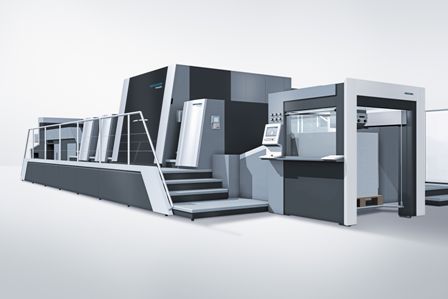
July 7th, 2017Print is omnipresent in everyday life. In a loose series of interviews, the VDMA Printing and Paper Technology Association presents industrial players from among its member companies. In this interview, Rainer Hundsdörfer, who took over the chair of the board of management of Heidelberger Druckmaschinen AG following positions at the technology manufacturersTrumpf, Schaeffler, Weinig and ebm papst, talks about his relationship with printing technology manufacturing, about digitization and growth plans for Heidelberg as well as the role of industrial printing in his strategy.
Mr. Hundsdörfer, did you settle down well in printing technology manufacturing?
Rainer Hundsdörfer: Yes, I did. After all, it is still technology manufacturing, with the same customer structuresas in the positions I held before. The majority of our machines go to medium-sized companies. Furthermore, I know printing technology manufacturing well since the first job I had after having finished my studies was at a supplier of products for printing machines. Therefore, I am well acquainted with the printing methods, and I visited nearly every drupa out of personal interest.
At the year-end press conferenceyou recently announced your objective to makeHeidelberg once again the (high-growth and profitable) lighthouse of the industry. How?
Hundsdörfer: We have all chances forthat. In my previous positions, I always looked up to Heidelberg as a market leader and a leading innovator. If you wanted to see a truly modern machinery manufacturing plant, you had to go to Heidelberg! My predecessors continued to make strong investments in research & development despite the difficult market situation – and have expanded the digital competence of the Group. This is a good basis in order to pick up the strength of the successful periods. We have ceased to manufacture only machines a long time ago, instead, we embed them into an end-to-end digital workflow. Our software starts at the point in time when the customers send their data to the printing house and covers the whole chain up to the delivery of the printed products. Thanks to this advanced digitization, we have access to a huge amount of data –no matter whether offset, flexographic, screen or gravure methods or inkjet processes are used for printing. Apart from the ink transfer, nothing else is analogue any more.
What do you want to do with the collected data?
Hundsdörfer:They offer us the possibility to create new digital business models. Previously, the machine was in the centre of all actions. In future, it will only be a means to an end. The first step is automation of the processes, including disposition of consumables. This makes our customers` lives easier. In the next step, we can optimize their productivity based on these data. And at least then it`s getting interesting, because this will be profitable for our customers and for us in equal terms. We can offer our customers a full service package, at the same time ensure optimum performance of their machines and automatically provide all consumables. In such models, the customer will even no longer have to buy the machine, but can pay us per printed sheet. We are in the process of testing such models.
Transfer the desktop model to industrial printingcompanies?
Hundsdörfer:It will still take some time. However, this is our chance to get back to the forefront: No longer in the pure competition for the best printing machine, but in the competition for the best business model for printing companies. For that, we, inter alia, prepare ourselves by systematically expanding our range of consumables. Unlike, for example, machine tools, printing machines consistently use large quantities of consumables. Consumables are a crucial element of our growth strategy. We, as a machinery manufacturer, want to get out of the pure input-based business and enter output-based business. Printing technology manufacturing has a market potential of 5 billion Euro – with offset and digital printing machines accounting for 50 percent each. The output value of the printing industry lies between 400 and 500 billion Euro per annum. If we take our share of the cake, growth will happen, and this business is by far less volatile than machinery manufacturing. In future, the machine is part of the “digital technology”.Its operating data are the key to “digital business”. Now, the structure of our Group is based on these two pillars.
This sounds very future-oriented – but also hints to changes for your staff…
Hundsdörfer:… which we must accept. I spend very much time on that. For, if we continue to act as before, we will not get rid of the stigma “Print and paper are dead“. Quite the contrary is true! Print is alive and omnipresent. However, our role is changing. I see us as enablers. We make the difference when it comes to the identification of brands and the communication of contents. It`s not by chance that packaging printing becomes more and more sophisticated, even with products that are marketed online. For, if the first impression does not communicate value, the customers will return the ordered product. Sophisticated packaging printing also offers additional benefits as, for instance, protection against plagiarists. Sequential numbering or micro embossing on packages pose real problems for counterfeiters.
Who are the customers for your digital business models?
Hundsdörfer:Global large companies have their own structures – and for smaller handicraft printshops, full-service offers also make little sense. However, they pay off for the majority of the medium-sized printing companies which increasingly use industrial processes and digitization! For them, it`s important that the processes in the pressroom run smoothly. This is what we can guarantee at favourable, exactly calculable conditions.
What is the role of industrial printing in your strategies?
Hundsdörfer:In printing like in other industrial sectors, industrialisation is the order of the day. The transformation from handicraft printing to industrial printing is in full progress. Heidelberg pushes this development with innovations, such as our Push-to-Stop philosophy or our industrial digital printing systems “Primefire”and “Labelfire”.What is important is that the innovation generates value for the customers. The availability and degree of automation are the key factors for this. In industrial processes, the machines must process the orders without any stop or manual interruptions for format changes. With our entry into digital packaging printing, we address exactly these issues: Availability, automation and maximum productivity. It is notenough to install an improved copier and call that industrial printing. In this case, the technical availability will not be sufficient. The crucial difference lies between handicraft and industrial printing. Heidelberg became the market leader with reliable technology – and will continue to score with that.
http://dup.vdma.org






